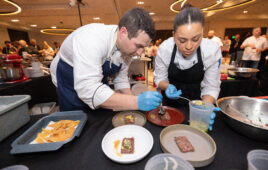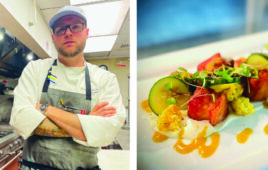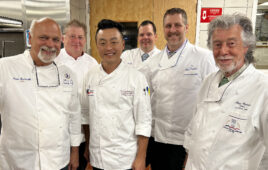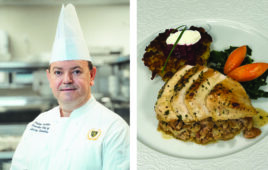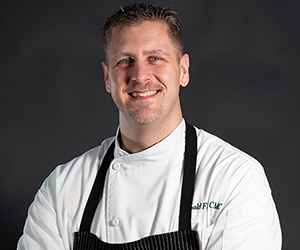
Gerald Ford, CMC, Founder and Culinary Director, Legit Concepts
Gerald Ford, CMC, Founder and Culinary Director of Legit Concepts and contributing editor to Club + Resort Chef, breaks flavor development into six steps.
“There are five basic tastes,” he says. “But flavor is much more complicated. It’s those sensations plus the environment and the aesthetic—all of those things put together. When I talk about flavor development, I’m talking about the fundamental building blocks of taste—and maximizing the food that’s being cooked to deliver the best-possible flavor within the parameters of the establishment, the outlet, the chef’s design, and kind of the recipe it comes from.”
The first step is process-based: What are the fundamental techniques that build flavor? Ford uses a braise as an example.
“Braising a piece of meat inherently builds its flavor,” he says. ‘When you take a piece of meat that’s a bit tougher and you cook it in onions, and celery, and carrots, and bay leaves, and you let it simmer until it’s tender, it leads to a different level of tastiness. That’s process-based flavor development.”
Once the process or the foundation is laid, step two is layering, or adding layers of flavor.
“Using the example of a braise,” he says, “in addition to the cooking process and the utilization of celery, onion, and carrots, if we add red wine or reduced veal stock, we’re adding other layers of flavor, which help support and enhance, further developing the flavor.”
While the first two steps are fundamental-based or foundation-based, step three is about creative decisions. Once you understand the process, and you understand how you can add levels of flavor, then you can start to substitute ingredients.
‘Instead of using water to make risotto,” Ford says, as an example, “you can use chicken stock. You’re enhancing the flavor by adding additional flavor. What’s even better is, as we get beyond the substitution, then we go to an enhancement layer, then we start using Parmesan cheese stock, which also adds additional flavor—making specific decisions on top of the fundamentals to develop that flavor further. And you can utilize things that would normally get thrown away. A Parmesan cheese stock can be made with the Parmesan cheese rinds, which most everybody throws away anyway.”
Step four is enhancement: adding things like salt, brewer’s yeast or MSG. And the fifth step is omission.
“We chefs all go through a stage where we add a ton of steps,” he says. “In my 20s, when I had a tomato, [I’d think about] all the cool things I could do with the tomato and put on the plate. And now I’m saying, do I need to do all of those things? Do we really need to buy all of these ingredients? Is it really better? If I’m trying to do a tomato 30 different ways, is it actually better than a perfectly ripe tomato with olive oil, salt and pepper?”
The sixth and final step, the highest level, is rethinking.
“That’s after you’ve exhausted all of those other pieces,” Ford says. “Once your process is fantastic and you’ve added in your flavors that are going to help enhance what’s there, you’ve made the substitutions that make the most sense, you’ve enhanced ingredients where you can, you’ve removed anything that doesn’t help your end result, then you could rethink or reinvent [the dish]. But I think of that last step in flavor development as highly optional. The majority of the time, if you do those other five things, then you don’t need to do the sixth step.”
Club + Resort Chef (C+RC): Can you give an example of a time you’ve utilized this step?
Gerald Ford (GF): Where you see step six a lot is when you go to the Culinary Olympics, or when you watch really high-level competitions. I remember a specific example on the Culinary Olympic team, making arancini. We were trying to rethink how to take this arancini and make it a bit more of an American experience.
Instead of using boreal rice, we started using Carolina rice grits. Instead of using a Parmesan cheese stock, using a cheddar cheese stock.
The rethinking step requires an end goal. What am I seeking out?
C+RC: It seems step six is a good tool for club chefs who want to find a new way to offer classic, member-favorite club recipes.
GF: Absolutely. It’s all based on understanding the fundamentals of what makes the dish the dish, and then modifying it.
The club [sandwich] gets ordered more than anything else. Members want a different version of the club, but then they get upset when the club gets changed. Once you understand what the club’s sandwich is—it’s turkey, it’s ham, it’s bacon, it’s lettuce, tomato, mayonnaise—from there, could you modify those things? Sure, you could. But then is it still a club?
C+RC: What are the biggest misconceptions about flavor?
GF: The majority of the time, great ingredients and great process lead to great flavor. I think the biggest misconception is that you have to do more to develop great flavor. It’s more about doing the right thing at the right time. Not everything needs to be reinvented. I guess that’s the old-school traditionalist in me coming out.
I think the standard for execution should be understood so that when modifying, or rethinking, or trying to, “enhance,” you understand what a great version of the baseline is. Part of the education of a good young cook should be understanding what a great example of a perfectly grilled piece of meat is, or understanding what can happen when you make a really nice, tasty stew using good fundamental technique, as opposed to trying to adjust and add ingredients.
Another misconception is that flavor development means higher cost. I would say it’s about picking the right ingredients, the best-quality ingredients that you can afford, and then applying the proper technique for execution.
C+RC: What are some effective ways of helping new chefs understand flavor principles?
GF: I think it comes down to tasting and understanding perception of taste. What’s spicy for me and what’s spicy for you are very different.
We need to make sure that we are leading the charge, that we’re tasting things and saying, “What do you taste? To me, it needs more salt.” Or, “This is why it needs a little bit of acid.” Having those conversations leads to the younger cooks having vocabulary and leads them to having the palate that they’re going to need to cook great food.
C+RC: How much of it do you think is learned through practice versus teaching?
GF: I would say it’s probably four-to-one practice-to-learning. Above all, craft is learned through doing. You can’t live in the realm of theory. I think that’s part of why our industry can be unappealing to some people; you really need to put in the time and the work.
C+RC: What resources on flavor development do you recommend?
GF: Salt, Fat, Acid, Heat by Samin Nosrat is another great book; it’s kind of an easy, simple entry point. The Flavor Bible is your next step up. It’s still easy to read. It’s still incredibly interesting. And then up from is The Flavor Matrix. I would not let my young cooks read that book. It’s interesting, but it starts talking about flavor compounds. And if you’re not ready for it, it’s going to take you down the wrong path. Then there’s another book called On Food and Cooking by Harold McGee that outlines the science of what’s happening in flavor development. That would be what I would call the advanced-geek level.
But The Flavor Bible, whenever I’m writing a menu, is my go-to. I have one at home. I have one in my office. I have one in my kitchen. I give it to all my sous chefs.
C+RC: What are your thoughts on globalization and how that impacts our culinary tastes here in the U.S.?
GF: It can be very cool. I think it helps expose people to food with flavor profiles at different levels, at different places. I think it keeps people from having a closed mind. But, as with anything else, I worry about homogenization of food and flavors. I still want to know what a korma would taste like in a particular region of India. I would still like to maintain that there’s that individuality of it, because I don’t want everything to eventually taste exactly the same.
I think culinary fusion, when based on a good, fundamental understanding of food, is a creative way to advance flavor or to develop food. But I think there’s also a point when it’s too much, and you can’t necessarily recognize what’s what or what makes great food.
And maybe that’s where The Flavor Bible helps guide decisions. There are some ingredients that are offensive to consume together. There are some cuisines that don’t fit together.
More than coming up with some creative new combination, it’s important to remember that our goal is to serve great food.

